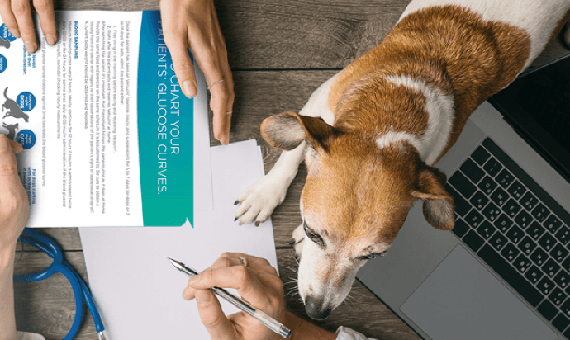

Spot Glucose Measurement
Read More About Monitoring & Controlling Canine Diabetes
Monitoring with Blood Samples
The term spot glucose measurement applies when a limited number of blood samples are taken at different intervals during the day. A regular glucose curve would require blood sampling every 1 to 2 hours for a period of 12–24 hours.
Spot Glucose Measurement Timing
The first blood sample should be taken early in the morning prior to the first meal and insulin injection. If insulin is usually administered prior to normal office hours, the first measurement should occur as close to administration as possible. The second blood sample should be taken approximately 4 hours later. When a rapid metabolism is suspected, it can be taken earlier. If the dog is injected twice a day, blood sampling should be done before each meal.
If hyperglycemia is detected but all other parameters suggest improvement and do not suggest instability (urine, appetite, water uptake, general condition), the dose likely does not require adjustment. To be certain, the tests can be repeated the next day. If the results confirm that there is reason for concern, a serial blood glucose curve should be made before the insulin dose is adjusted.
Precaution
It is impossible to differentiate a Somogyi overswing from rapid metabolism or resistance to insulin with only a few blood samples. If these conditions are suspected, a blood glucose curve should be recommended.
Glucose Blood Sampling
A glucometer or glucose test strips are needed to test the blood. Check instructions from the glucometer or test strips. Blood can be collected easily from the patient’s pinna. Alternate sites, including tail, lip, callous and foot pads could be considered depending on preference and dog’s comfort level.
Step 1 Make sure that the dog’s ear is warm for easier collection. Warm between palms if needed.
Step 2 Quickly prick a clean, hairless part of the ear with a sterile lancet or hypodermic needle. A lancet provides the advantage of controlled, consistent depth.
Step 3 Collect the blood droplet onto the glucose test strip as per instructions provided.
Step 4 Gently but firmly press clean cotton or gauze onto the dog’s ear until it stops bleeding.
Step 5 Read the test strip or insert the sample into the glucometer as instructed. Compare the reading to the normal level in dogs.
If blood samples are taken at home, a record of the time of sampling readings should be kept to share with the veterinarian.
Resources to Help Clients Monitor Care
Help Your Practice Manage Diabetes Mellitus
View and download resources and tools that will assist your hospital, inform your team, and help with clients.

Blood Glucose Curve Generator
Create a blood glucose curve to monitor and evaluate diabetes treatments.

Client Discharge Form
Create a customized, printable form for clients about their new diagnosis.

Diabetes Resources
Access online tools and more to support staff and pet parents.
No items to show.
Read More About Monitoring &Controlling Canine Diabetes
Important Safety Information:
Vetsulin® should not be used in dogs known to have a systemic allergy to pork or pork products. Vetsulin is contraindicated during periods of hypoglycemia. Keep out of reach of children. As with all insulin products, careful patient monitoring for hypoglycemia and hyperglycemia is essential to attain and maintain adequate glycemic control and prevent associated complications. Overdosage can result in profound hypoglycemia and death. The safety and effectiveness of Vetsulin in puppies, breeding, pregnant, and lactating dogs has not been evaluated. See package insert for full information regarding contraindications, warnings, and precautions.
References:
1. Martin GJ, Rand JS. Pharmacology of a 40 IU/ml porcine lente insulin preparation in diabetic cats: findings during the first week and after 5 or 9 weeks of therapy. J Feline Med Surg. 2001;3(1):23–30. 2. Vetsulin® (porcine insulin zinc suspension) [Freedom of Information Summary]. Millsboro, DE: Intervet Inc.; 2008. 3. Data on file, Merck Animal Health. 4. Graham PA, Nash AS, McKellar QA. Pharmacokinetics of porcine insulin zinc suspension in diabetic dogs. J Small Anim Pract. 1997;38(10):434–438. 5. Martin GJ, Rand JS. Pharmacokinetic and Pharmacodynamic Study of Caninsulin in Cats with Diabetes Mellitus. 2000: Internal Study Report. 6. Feldman EC, Nelson RW. Canine and Feline Endocrinology and Reproduction. 3rd ed. St. Louis, MO: Saunders; 2004:539–579. 7. Tennant B, ed. BSAVA Small Animal Formulary. 4th ed. Gloucestershire, UK: British Small Animal Veterinary Association; 2002. 8. Feldman EC, Nelson RW. Canine and Feline Endocrinology and Reproduction. 3rd ed. St. Louis, MO: Saunders; 2004:486–538. 9. Reusch C. Feline diabetes mellitus. In: Ettinger SJ, Feldman EC, eds. Textbook of Veterinary Internal Medicine. 7th ed. St. Louis, MO: Saunders; 2010:1796–1816. 10. Nelson RW. Canine diabetes mellitus. In: Ettinger SJ, Feldman EC, eds. Textbook of Veterinary Internal Medicine. 7th ed. St. Louis, MO: Saunders; 2010:1782–1796. 11. Burgaud S, Riant S, Piau N. Comparative laboratory evaluation of dose delivery using a veterinary insulin pen. In: Proceedings of the WSAVA/FECAVA/BSAVA congress; 12–15 April 2012; Birmingham, UK. Abstract 121. 12. Burgaud S, Guillot R, Harnois-Milon G. Clinical evaluation of a veterinary insulin pen in diabetic dogs. In: Proceedings of the WSAVA/ FECAVA/BSAVA congress; 12–15 April 2012; Birmingham, UK. Abstract 122. 13. Burgaud S, Guillot R, Harnois-Milon G. Clinical evaluation of a veterinary insulin pen in diabetic cats. In: Proceedings of the WSAVA/FECAVA/BSAVA congress; 12–15 April 2012; Birmingham, UK. Abstract 45. 14. Davison LJ, Walding B, Herrtage ME, Catchpole B. Anti-insulin antibodies in diabetic dogs before and after treatment with different insulin preparations. J Vet Intern Med. 2008;22:1317-1325. 15. Banfield State of Pet Health 2016 Report. p 12-13.
